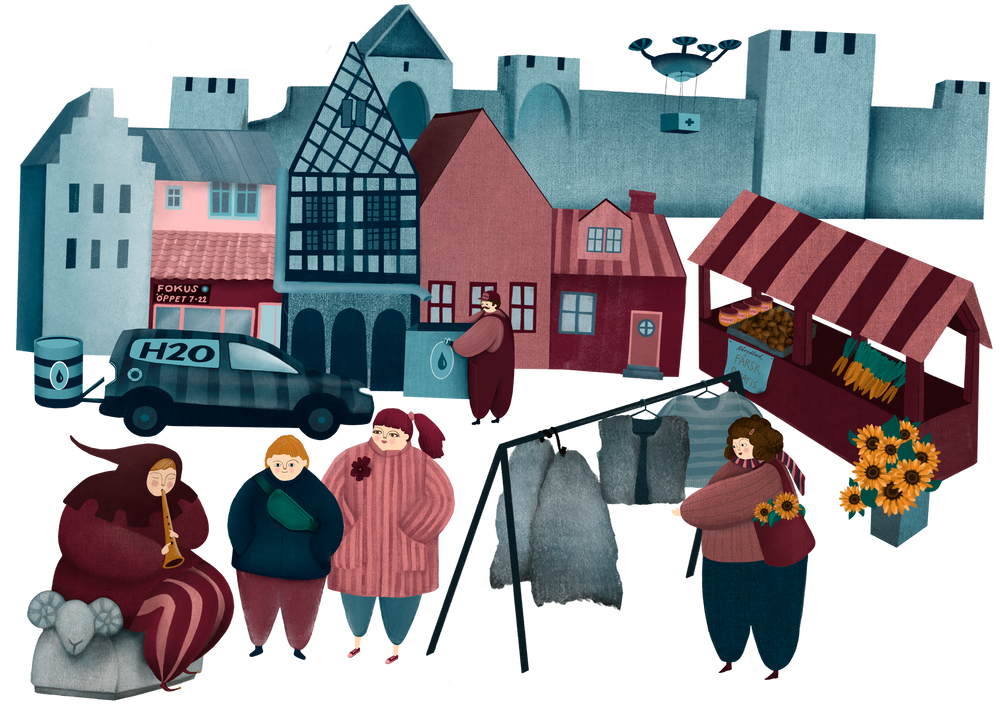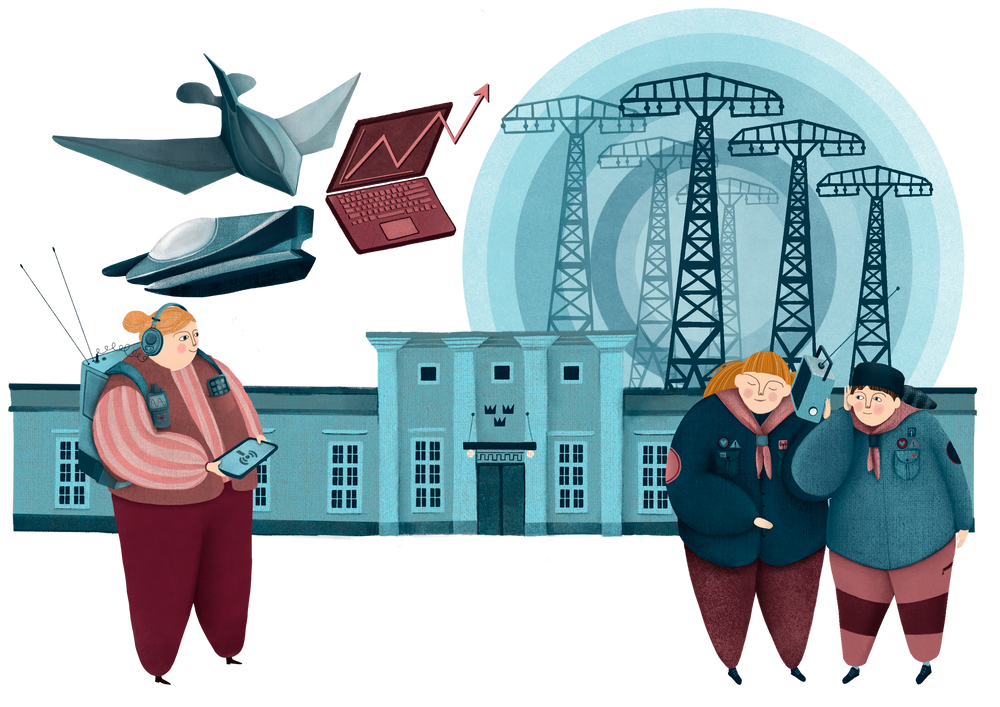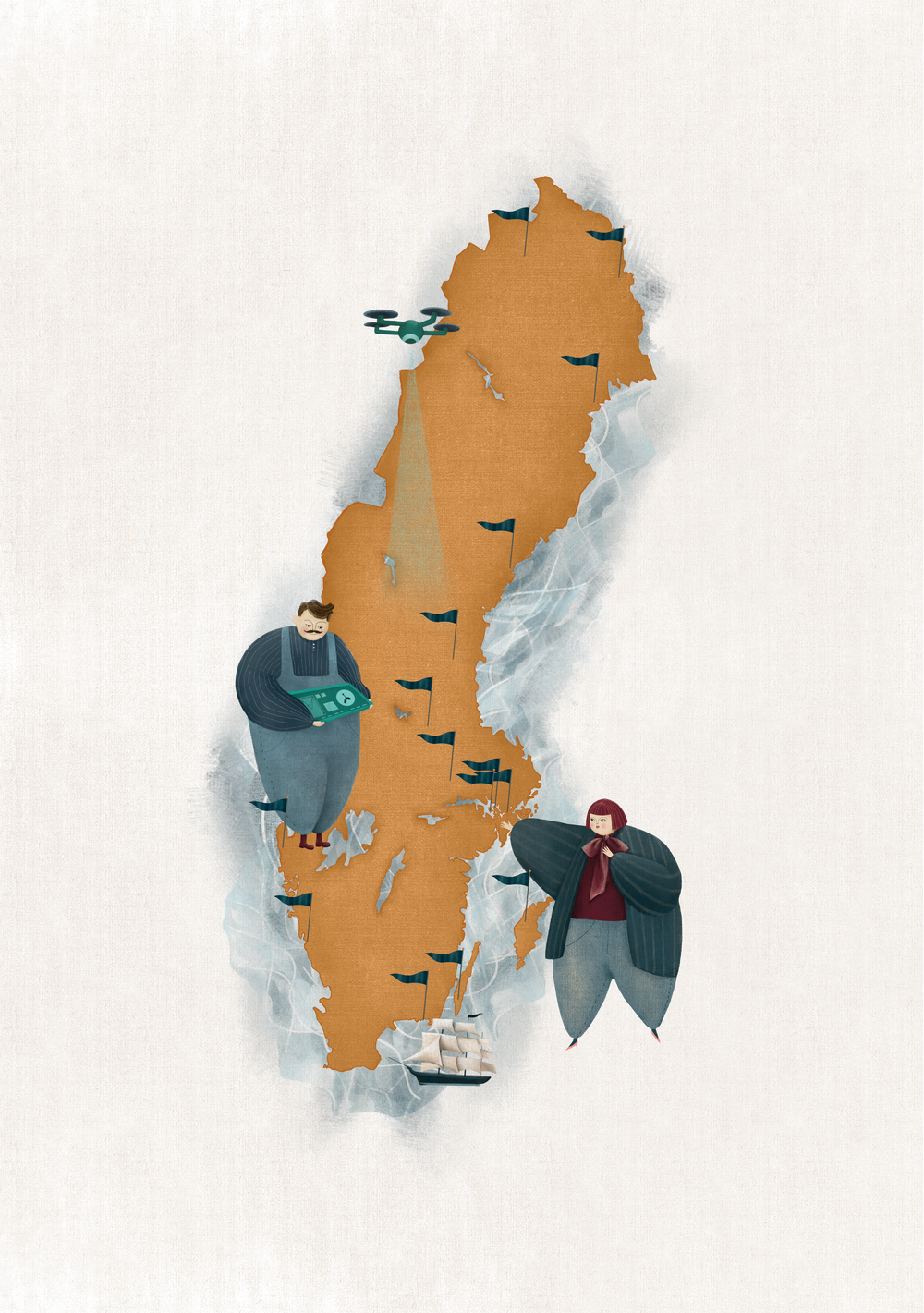PRESS RELEASE:
Sweden has 15 World Heritage Sites, each with a unique story about our shared history. These places, recognized by UNESCO for their value to all of humanity, have the potential to promote sustainable development and peace, while offering value to local communities. Despite this, World Heritage Sites remain unknown to many Swedes. In the project World Heritage Sites in Sweden – Places That Make a Difference, with main funding from the Swedish Agency for Economic and Regional Growth, the goal has been to highlight the importance of World Heritage Sites for society in a clear and accessible way.
The Hanseatic Town of Visby – Illustration World Heritage Sites in Sweden
Annefrid Sjöman has been commissioned to interpret the various World Heritage Sites in Sweden through different illustrations. The aim has been to highlight both the unique values of the sites and their relevance for the future in terms of sustainability and a better world.
“For World Heritage Sites to be relevant and interesting, we need to understand that we are competing with other brands, products, services, places, and other information for the target audience’s attention,” says Sofia Mård Ek, brand strategist at Placebrander, one of the project’s partners.
A National Toolkit for Simple Storytelling
With the help of Placebrander, the World Heritage Sites have crafted a common place narrative and a toolkit that all World Heritage actors can use in the future. It makes it easier for both local actors and decision-makers to collaborate and spread knowledge about World Heritage Sites. Even Placebrander’s place development professionals have become aware of the role of World Heritage Sites.
“Stepping into the everyday life of so many World Heritage Sites and seeing the difference they have made and continue to make for social development and peace was an eye-opener and great inspiration. Also seeing that the process itself has benefited the collaboration between all these unique places has been incredibly fun to follow. This is truly relevant and sustainable place development in its finest form!” says Sofie Gunnarsson at Placebrander.
With simplified communication, more people can gain a better understanding of the places, why they are important, and what they contribute locally, regionally, nationally, and internationally. Strengthening awareness is a first step towards creating a long-lasting commitment to preserving these places for future generations.
Three Specific Messages:
- World Heritage Sites are places that make a difference
Clear communication is key to answering questions about what a World Heritage Site is and why it plays an important role in our world, both broadly and locally. World Heritage Sites are unique places that not only preserve our history but also make a positive difference by inspiring sustainability, community, and peace. - World Heritage Sites belong to all people and are part of the future
The forward-looking dimension is central, and through it, we can highlight the importance of World Heritage Sites for sustainable development and peace, which is at the core of UNESCO’s vision. Preserving and learning from World Heritage Sites strengthens our connection to history and gives us insights that are important for a more peaceful future. - World Heritage Sites are found all over the world, and 15 of them are in Sweden
Knowledge about World Heritage Sites in Sweden needs to be spread so that more people understand what these places represent and what they contribute. Knowing and appreciating that there are 15 World Heritage Sites here, and understanding their unique value, increases engagement in preserving them for future generations.
What is a World Heritage Site? With three short videos, World Heritage Sites become more understandable to many more people.
Only 29% of Swedes Can Explain What a World Heritage Site Is
Making the message of World Heritage Sites more accessible is a central part of the project. Within the project, a national attitude survey was conducted where 71% of respondents said they could not explain what a World Heritage Site means. This clearly showed that a new approach is needed to increase understanding of World Heritage Sites nationally. For example, through simple and easily understandable language, adapted to different target groups – from decision-makers and residents to visitors of all ages.
“World Heritage Sites are global. They are unique places that are important to all of humanity and show that there is actually more that unites us than divides us. Those of us who work daily with World Heritage Sites want more people to feel that the World Heritage Sites are truly ‘theirs,’ and for that to happen, people must be able to grasp both the concept and what these incredible places give to society,” says Camilla Lugnet, project manager and CEO of the Grimeton World Heritage Site.
The project has also, with the help of Rickard Heldemyr, developed a common visual style and examples of different ways to increase recognition when all World Heritage Sites in Sweden are communicated. These will be tools in a shared toolkit that can be used by World Heritage actors, teachers, decision-makers, and others who want to spread the message about the importance of World Heritage Sites for society and a more peaceful world.
“Peace is built on our view of humanity. Being curious plays a big role! World Heritage Sites help us understand our history and thereby each other – that’s UNESCO’s idea for building a more peaceful world. As a reassuring companion through the visual style, you see Mother Earth highlighting the World Heritage Sites,” says Elena Peverada, World Heritage coordinator for the Naval Port of Karlskrona World Heritage Site and participant in the project.
World Heritage Sites in Sweden – Mother Earth
About the Project World Heritage Sites in Sweden – Places that Make a Difference
The Swedish Agency for Economic and Regional Growth has provided the main funding for the project. The Grimeton World Heritage Foundation has owned, operated, and, like Karlskrona Municipality, Mörbylånga Municipality, and Region Gotland, also co-financed it. The engagement has been made based on these actors together managing part of our common heritage, namely Grimeton Radio Station, the Naval Port of Karlskrona, the Agricultural Landscape of Southern Öland, and the Hanseatic Town of Visby.
The non-profit association World Heritage Sites in Sweden has supported the project and become the recipient of the results.
Grimeton World Heritage Site – illustration by World Heritage Sites in Sweden – Places That Make a Difference.
Media Contacts
Lena Bager, kommunikation@grimeton.org, +46 768 08 89 25
Communication PR Grimeton World Heritage Site
Camilla Lugnet, CEO Grimeton Radio Station World Heritage Site, camilla.lugnet@grimeton.org
Press images: The power of World Heritage Sites for peace and social development is now clearer
These are the World Heritage Sites in Sweden
UNESCO World Heritage Sites are found all over the world, and we have the joy of having 15 of them in Sweden! Together they form the world’s great book where each place contributes a unique story. Join us on a journey from north to south through these 15 outstanding places.
In the far north, we find measuring points in the Struve Geodetic Arc, which stretches through ten countries. Here we also find Laponia and Gammelstad Church Town. Now we make a stop at the High Coast/Kvarken Archipelago, which extends into Finland. Then we continue our journey to the Decorated Farmhouses of Hälsingland, Falun and the Copper Mountain, and Engelsberg Ironworks. Near our capital, we find the Drottningholm Palace area, the Woodland Cemetery, and Birka and Hovgården. We move on to the west coast where we find the Rock Carvings in Tanum and Grimeton Radio Station. Our journey ends with three pearls in the Baltic Sea, the Hanseatic Town of Visby, the Agricultural Landscape of Southern Öland, and the Naval Port of Karlskrona.
ViS, World Heritage Sites in Sweden, is a non-profit interest organization for the natural and cultural heritage sites in Sweden that have been included on UNESCO’s World Heritage List. The association’s purpose is to run a network that supports the management of World Heritage Sites in Sweden. ViS is also involved in Nordic and European cooperation. Through national and international collaboration, ViS works to strengthen ties, share experiences, and promote development in natural and cultural heritage work.
World Heritage Sites in Sweden #placesthatmakeadifference





